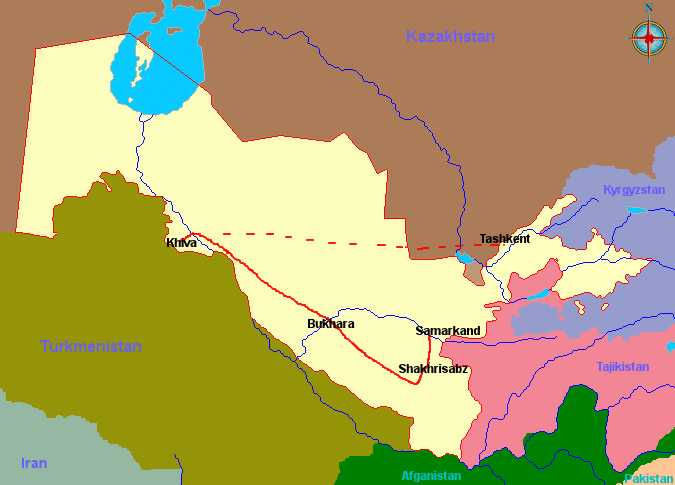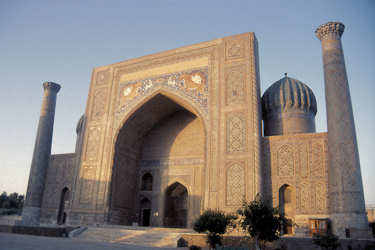Uzbekistan

Historie
The first people known to have occupied Central Asia were Iranian Nomads who arrived from the northern grasslands of what is now
Kazakhstan sometime in the first millennium BC. These nomads, who spoke Iranian dialects, settled in Central Asia and began to build an extensive
irrigation system along the rivers of the region. At this time, cities such as Bukhara and Samarqand began to appear as centers
of government and culture. By the fifth century BC, the Bactrian, Soghdian, and Tokharian states dominated the region.
As China began to develop its silk trade with the West, Iranian cities took advantage of this commerce by becoming centers of trade. Using
an extensive network of cities and settlements in the province of Transoxiana in Uzbekistan and farther east in what is today China's Xinjiang,
the Soghdian intermediaries became the wealthiest of these Iranian merchants.
Because of this trade on what became known as the Silk Route, Bukhara and Samarqand eventually became extremely wealthy cities, and at
times Transoxiana was one of the most influential and powerful Persian provinces of antiquity.
Alexander the Great conquered the region in 328 BC, bringing it briefly under the control of his Macedonian Empire.
The wealth of Transoxiana was a constant magnet for invasions from the northern steppes and from China. Numerous intraregional wars were fought
between Soghdian states and the other states in Transoxiana, and the Persians and the Chinese were in perpetual conflict over the region.
The Chinese in particular sought the Heavenly Horses from the region, going so far as to wage a siege war against Dayuan, an
urbanized civilization in the Fergana Valley in 104 BC to obtain the horses.
In the same centuries, however, the region also was an important center of intellectual life and religion. Until the first centuries after Christ,
the dominant religion in the region was Zoroastrianism, but Buddhism, Manichaeism, and Christianity also attracted large numbers of
followers.
The conquest of Central Asia by Muslim Arabs, which was completed in the eighth century AD, brought to the region a new religion that
continues to be dominant. The Arabs first invaded Transoxiana in the middle of the seventh century through sporadic raids during their conquest
of Persia.
During the height of the Abbasid Caliphate in the eighth and the ninth centuries, Central Asia and Transoxiana experienced a truly golden
age. Bukhara became one of the leading centers of learning, culture, and art in the Muslim world.
Some of the greatest historians, scientists, and geographers in the history of Islamic culture were natives of the region.
In the ninth century, the continued influx of nomads from the northern steppes brought a new group of people into Central Asia. These people were
the Turks who lived in the great grasslands stretching from Mongolia to the Caspian Sea.
The first of the Turkic states in the region was the Persianate Ghaznavid Empire, established in the last years of the tenth century.
The dominance of Ghazna was curtailed, however, when the Seljuks led themselves into the western part of the region, conquering the
Ghaznavid territory of Khorazm.
The Seljuks dominated a wide area from Asia Minor, Iran, Iraq, and parts of the Caucasus, to the western sections of Transoxiana, in Afghanistan,
in the eleventh century.
The Mongol Invasion of Central Asia, which took place from 1219 to 1225, is one of the turning points in the history of the region. The
Mongols had such a lasting effect because they established the tradition that the legitimate ruler of any Central Asian state could only be a
blood descendant of Genghis Khan.
In the early fourteenth century, however, as the empire began to break up into its constituent parts, the territory also was disrupted as the
princes of various tribal groups competed for influence. One tribal chieftain, Timur, emerged from these struggles in the 1380s as the
dominant force. Although he was not a descendant of Genghis, Timur became the de facto ruler and proceeded to conquer all of western Central Asia,
Iran, Asia Minor, and the southern steppe region north of the Aral Sea. He also invaded Russia before dying during an invasion of China in 1405.
The Timurid state quickly broke into two halves after the death of Timur. The chronic internal fighting of the Timurids attracted the attention
of the Uzbek Nomadic Tribes living to the north of the Aral Sea.
By 1510 the Uzbeks had completed their conquest of Central Asia, including the territory of the present-day Uzbekistan. Of the states they
established, the most powerful, the Khanate of Bukhara
A second Uzbek state, the Khanate of Khiva was established in the oasis of Khorazm at the mouth of the Amu Darya in 1512.
Near the end of the sixteenth century, the Uzbek states of Bukhara and Khorazm began to weaken because of their endless wars against each other
and the Persians and because of strong competition for the throne among the khans in power and their heirs.
The Uzbeks' struggle with Iran also led to the cultural isolation of Central Asia from the rest of the Islamic world. In addition to these problems,
the struggle with the nomads from the northern steppe continued.
In the late eighteenth and early nineteenth centuries new dynasties led the khanates to a period of recovery. Those dynasties were the Qongrats
in Khiva, the Manghits in Bukhara, and the Mins in Quqon. These new dynasties established centralized states with standing armies
and new irrigation works.
But their rise coincided with the ascendance of Russian Power in the Kazakh steppes and the establishment of a British Position
in Afghanistan. By the early nineteenth century, the region was caught between these two powerful European competitors, each of which tried to
add Central Asia to its empire in what came to be known as the Great Game.
The Central Asians, who did not realize the dangerous position they were in, continued to waste their strength in wars among themselves and in
pointless campaigns of conquest.
In the nineteenth century, Russian interest in the area increased greatly, sparked by nominal concern over British designs on Central Asia; by
anger over the situation of Russian citizens held as slaves; and by the desire to control the trade in the region and to establish a secure source
of cotton for Russia.
As soon as the Russian conquest of the Caucasus was completed in the late 1850s, the Russian Ministry of War began to send military forces
against the Central Asian khanates.
By 1876 the entire territory comprising present-day Uzbekistan either had fallen under direct Russian rule or had become a protectorate of Russia.
By the beginning of 1920, Central Asia was firmly in the hands of Russia and, despite some early resistance to the Bolsheviks, Uzbekistan and
the rest of the Central Asia became a part of the Soviet Union. On 27 October 1924 the Uzbek Soviet Socialist Republic was created.
The Russians substantially increased Cotton Production. Although railroads and cotton-ginning machinery advanced, the Central Asian textile
industry was slow to develop because the cotton crop was shipped to Russia for processing.
As the tsarist government expanded the cultivation of cotton dramatically, it changed the balance between cotton and food production, creating
some problems in food supply—although in the prerevolutionary period Central Asia remained largely self-sufficient in food.
This situation was to change during the Soviet period when the Moscow government began a ruthless drive for national self-sufficiency in cotton.
This policy converted almost the entire agricultural economy of Uzbekistan to cotton production, bringing a series of consequences whose harm still
is felt today in Uzbekistan and other republics.
On 31 August 1991, Uzbekistan declared independence after the failed coup attempt in Moscow. 1 September was proclaimed the National Independence
Day. The Soviet Union was dissolved on 26 December of that year.
Islam Karimov, ruler of Uzbekistan since independence, died on 2 September 2016. He was replaced by his long-time Prime Minister, Shavkat
Mirziyoyev, on 14 December of the same year.
I visited Uzbekistan in july 2001
On that trip i have seen
Tashkent
Khiva
Bukhara
Shakhrisabz
Samarkand
Please let me know when you're having questions.
i would be pleased to help you.
Things to do and other tips
